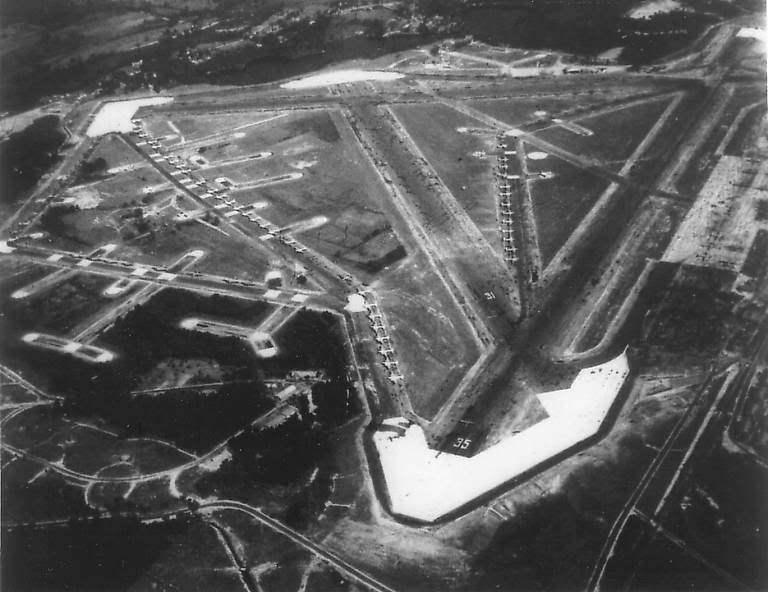Grenier
Airfield
Grenier Army Airfield in July 1944. Serving the 8th Air Force needs in Europe
Object Number - UPL 32446 - Grenier Army Airfield July 1944
On 1 January 1944, Grenier Field became the headquarters of the North Atlantic Division of Air Transport Command (ATC). Its primary mission was the ferrying of aircraft from the United States to Great Britain. Using airfields at Presque Isle, and Dow, Maine, ATC ferried thousands of combat and non-combat aircraft through airfields in Newfoundland and Labrador through Greenland and Iceland to Scotland. Long-range transports could also fly directly across the Atlantic to England or via the Azores Islands. The Air Weather Service established a detachment at Grenier which provided long-range weather reconnaissance over the North Atlantic convoy shipping lanes.
Grenier Field became involved in a bold Army Air Force plan known as Bolero in June, 1942. Bolero was a code name for the rapid buildup of American combat forces in England. Wartime transatlantic crossings by multi-engine aircraft had become routine, but the supply of fighter aircraft to England was a different matter. The most common method of crossing had been as deck cargo aboard surface vessels. Aside from being prohibitively slow and risky, this method exposed the relatively delicate airframes to manhandling and the corrosive effects of saltwater. An innovative plan was developed whereby the fighters would be ferried across the ocean in a series of short hops with navigational assistance provided by bombers. Most Bolero fighters departed from Presque Isle AAF, Maine, but during June 1942, the 52nd Fighter Group began to work up with Bell P-39 Airacobras at Manchester. Army Air Force leaders soon decided the P-39 was not an ideal fighter for the European theater, and the personnel of the 52nd went to England by ship. It wasn't until late in the year, after being reequipped with the legendary Spitfire fighter, that the 52nd began to operate from England as a combat fighter group.
Connections
See how this entry relates to other items in the archive by exploring the connections below.
Detailed History
The Manchester Airport was established in 1936, and commercial flights served the local area. By 1937, a classic art deco terminal would be built that would eventually become the Aviation Museum of New Hampshire.
On October 3, 1940, the War Department announced that the Manchester Airport would be developed as Manchester Army Air Base. Expansion efforts began immediately. The Works Project Administration (WPA) broke ground on October 7 under a $1.5 million allotment for base construction. During December, work began around the clock on the strengthening and expansion of the airfield's runway and tarmac areas.
On February 22, 1942, the base was dedicated as Grenier Army Airfield to honor 2nd Lt. Jean Donat Grenier, born in Manchester on November 24, 1909, and killed on February 16, 1934, in the crash of Curtiss A-12 Shrike 33-244 in bad weather at Oakley, Utah, while flying an advance air mail route between Salt Lake City and Cheyenne, Wyoming.
Air Transport Command (ATC) personnel visited Grenier on December 4, 1943, and recommended the North Atlantic Wing (NAW) relocate there from Presque Isle AAF, Maine. The New Hampshire site offered several major advantages over the previous location. There were three 150 foot-wide paved runways at Grenier that ranged in length from 5500 feet to 7000 feet. The annual snowfall was considerably less than the Maine location, and close proximity to the coast made it a convenient alternate landing site for aircraft inbound from Europe.
The air base remained through the Korean War. In early 1950s, the New Hampshire National Guard located here.
Aircraft
- Aircraft Type: B-17 Flying Fortress
- Nicknames: Royal Flush III
- Unit: 547th Bomb Squadron 384th Bomb Group
- Aircraft Type: B-17 Flying Fortress
- Nicknames: Snuffy
- Unit: 384th Bomb Group 546th Bomb Squadron

- Aircraft Type: B-17 Flying Fortress
- Nicknames: Knock-Out Baby!
- Unit: 95th Bomb Group 412th Bomb Squadron

- Aircraft Type: B-17 Flying Fortress
- Nicknames: Lady Margaret
- Unit: 384th Bomb Group 547th Bomb Squadron

- Aircraft Type: B-17 Flying Fortress
- Nicknames: Shoo Shoo Baby
- Unit: 95th Bomb Group 334th Bomb Squadron
Revisions
Documenting Airfields which served bombers of the 91st Bomb Group on their way to the UK.
Patrick Milward